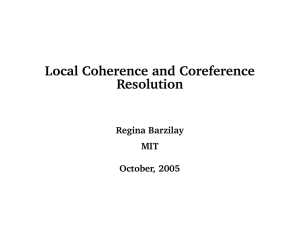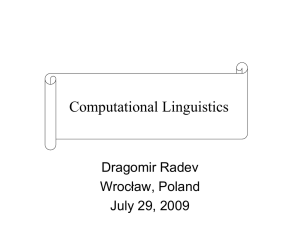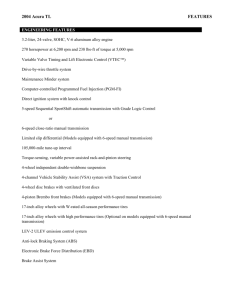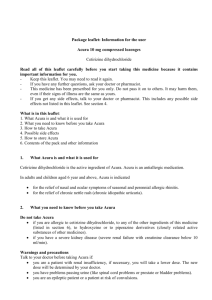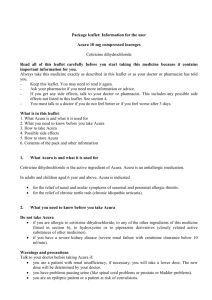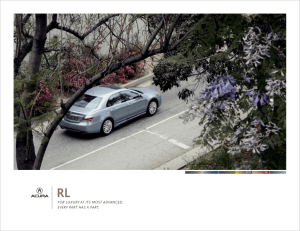Reference Resolution � Regina Barzilay February 18, 2004
advertisement
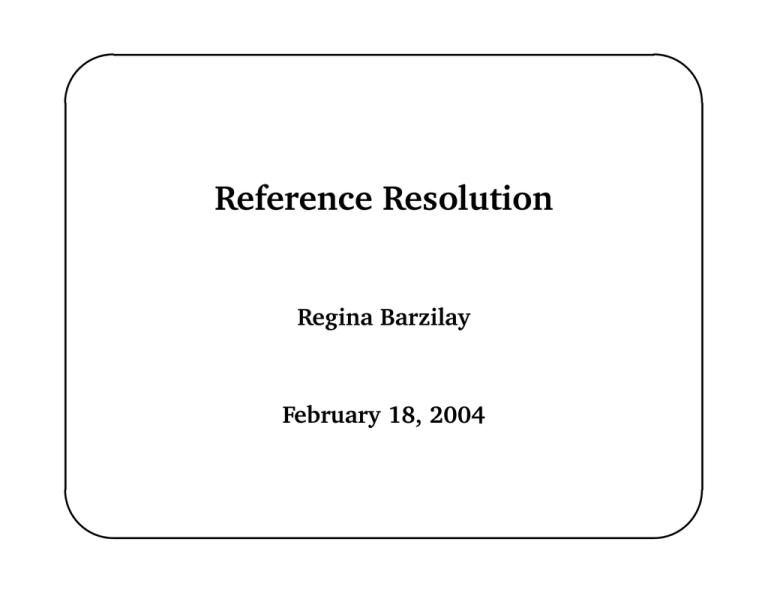
�
�
Reference Resolution
Regina Barzilay
February 18, 2004
�
�
�
�
Reference Resolution: Example
The Salesgirl (Burns and Allen)
Gracie: And then Mr. and Mrs. Jones were having matrimonal
trouble, and my brother was hired to watch Mrs. Jones.
George: Well, I am imagine she was a very attractive woman.
Gracie: She was, and my brother watched her day and night for
six month.
George: Well, what happened?
Gracie: She finally got a divorce.
George: Mrs. Jones?
Gracie: No, my brother’s wife.
�
Reference Resolution
�
1/??
�
�
Reference Resolution
• Task: determine which noun phrases refer to each
real-world entity mentioned in a document
• Goal: partition noun phrases in a text into
coreference equivalence classes, with one cluster for
each set of coreferent NPs
• Difference between anaphora and coreference
In the previous example: {Mrs. J2ones, she, she, Mrs. Jones},
{my brother, my brother}, {my brother’s wife}
�
Reference Resolution
�
3/??
�
�
Today’s Topics
• Motivation
• Types of referential expressions
• Syntactic and semantic constraints on coreference
• Preferences in coreference interpretation2
• Algorithm’s for coreference resolution
�
Reference Resolution
�
4/??
�
�
Motivation
• Information extraction
• Question-Answering
•
Machine-Translation
pronoun in the Malay language is translated by its antecedent
(Mitkov, 1999)
• Summarization
�
Reference Resolution
�
5/??
�
�
When something goes wrong
In the past decade almost all Islamic revivalist movements
have been labeled fundamentalists, whether they be of
extremist or moderate origin. The widespread impact of
the term is obvious from the following quotation from one
of the most influential Encyclopedias under the title
‘Fundamentalist’: “The term fundamentalist has. . . been
used to describe members of militant Islamic groups.” Why
would the media use this specific word, so often with
relation to Muslims? Most of them are radical Baptist,
Lutheran and Presbyterian groups.
�
Reference Resolution
�
6/??
�
�
When something goes wrong
Why would the media use this specific word, so often with
relation to Muslims?
Before the term fundamentalist was branded for Muslims,
it was, and still is, being used by certain Christian
denominations. Most of them are radical Baptist,
Lutheran and Presbyterian groups.
�
Reference Resolution
�
7/??
�
�
Types of referential expressions: Nouns
• Indefinite Noun Phrases:
I saw an Acura Integra today.
Some Acura Integras were being unloaded.
I saw this awesome Acura Integra today.
• Definite Noun Phrases
I saw an Acura Integra today. The Integra was white and needed
to be washed.
The fastest car in the Indianapolis 500 was an Integra.
�
Reference Resolution
�
8/??
�
�
Pronouns
Stronger constrains on using pronouns than on noun
phrase references.
• Require a high degree of activation from a referent
• Have short activation span
a. John went to Bob’s party, and parked next to a Acura Integra.
b. He went inside and talked to Bob for more than an hour.
a. Bob told him that he recently got engaged.
b. ??He also said that he bought it yesterday.
�
Reference Resolution
�
9/??
�
�
Demonstratives and One Anaphora
• Demonstratives (this, that) capture spatial proximity
I like this one, better than that
• One Anaphora evokes a new entity into the
discourse whose description is dependent of this
new entity
I saw no less that 6 Acuras today. Now I was one.
�
Reference Resolution
�
10/??
�
�
Troublemakers
• Inferrables: inferential relation to an evoked entity
I almost bought an Acura today, but a door had a dent and the
engine seemed noisy.
• Discontinuous Sets: refer to entities that do not
form a set in a text
John has an Acura, and Mary has a Mazda. They drive them all
the time.
• Generics: refer to general set of entities (in contrast
to a specific set mentioned in text)
I saw no less than six Acuras today. They are the coolest cars.
�
Reference Resolution
�
11/??
�
�
Syntactic Constraints on Coreference
• Number Agreement
* John has a new Acura. They are red.
John has three New Acuras. It is red.
• Person and Case Agreement
* John and Mary have Acuras. We love them.
You and I have Acuras. We love them.
�
Reference Resolution
�
12/??
�
�
Syntactic Constraints
• Gender Agreement
John has an Acura. It is attractive.
• Syntactic Agreement
John bought himself a new Acura.
John bought him a new Acura.
�
Reference Resolution
�
13/??
�
�
Semantic Constraints
• Selectional restrictions of the verb on its arguments
(1) John parked his Acura in the garage. He had driven it around
for hours.
(2) John parked his Acura in the garage. It is incredibly messy,
with old bike and car parts lying around everywhere.
(3) John parked his Acura in downtown Beverly Hills. It is
incredibly messy, with old bike and car parts lying around
everywhere.
�
Reference Resolution
�
14/??
�
�
Preferences in Pronoun Interpretation
• Recency: Entities introduced in recent utterances
are more salient than those introduced further back
John has an Integra. Bill has a Legend. Mary likes to drive it.
• Repeated mention: Entities that have been focus on
in the prior discourse are more likely to continue to
be focused on in subsequent discourse
John needed a car to get his new job. He decided that he wanted
something sporty. Bill went to the Acura dealership with him. He
bought an Integra.
�
Reference Resolution
�
15/??
�
�
Preferences in Pronoun Interpretation
• Grammatical Role: Hierarchy of candidate entities
based on their grammatical role
John went to the Acura dealership with Bill. He bought an
Integra.
Bill went to the Acura dealership with John. He bought an
Integra.
• Parallelism:
Mary went with Sue to the Acura dealership. Sally went with her
to the Mazda dealership.
�
Reference Resolution
�
16/??
�
�
Preferences in Pronoun Interpretation
Verb Semantics: emphasis on one of verb’s arguments
• “implicit causality” of a verb causes change in
salience of verb arguments
John telephoned Bill. He lost the pamphlet on Acuras.
John criticized Bill. He lost the pamphlet on Acuras.
• thematic roles (Goal, Source) cause change in
salience of verb arguments
John seized the Acura pamphlet from Bill. He loves reading
about cars.
John passed the Acura pamphlet to Bill. He loves reading about
cars.
�
Reference Resolution
�
17/??
�
�
Generic Algorithm
• Identification of Discourse Entities
Identify nouns and pronouns in text
•
Characterization of Discourse Entities
Compute for each discourse entity NPi a set of values from
{Ki1 , . . . , kim } from m knowledge sources
• Anaphoricity Determination
Eliminate non-anaphoric expressions to cut search space
• Generation of Candidate Antecedents
Compute for each anaphoric NPj a list of candidate antecedents
Cj
�
Reference Resolution
�
18/??
�
�
Generic Algorithm(cont.)
• Filtering
Remove all the members of Cj that violate reference constraints
• Scoring/Ranking
Order the candidates based on preferences and soft constraints
• Searching/Clustering
Clustering of instances with the same antecedent
�
Reference Resolution
�
19/??
�
�
Reference Resolution: Trends
• Knowledge-Rich Approaches vs Knowledge-Lean
Approaches
• Semi-automatic Fully-Automatic Preprocessing
• Small-scale vs Large-Scale Evaluation
�
Reference Resolution
�
20/??
�
�
Knowledge-Lean Multi-strategy Approach
(Lappin&Leass, 1994)
• Integrates the effects of the recency and
syntactically-based preferences
• Doesn’t rely on semantic or pragmatic knowledge
• Follows greedy strategy
• Two stages: discourse model update and pronoun
resolution
�
Reference Resolution
�
21/??
�
�
Discourse Model Update
(Lappin&Leass, 1994)
• Add every new discourse entity to discourse model
• Update its value based on salience factors
• Cut in half recency values when process new entity
(recency enforcement)
�
Reference Resolution
�
22/??
�
�
Salience Factors
Sentence Recency
100
Subject Emphasis
80
Existential Emphasis
70
Accusative
50
Indirect Object
40
Non-adverbial Emphasis
50
Head-noun Emphasis
80
�
Reference Resolution
�
23/??
�
�
Syntactic Factors
subject > existential predicate nominal > object >
indirect object > demarcated adverbial PP
1. An Acura Integra is parked on the lot. (subject)
2. There is an Acura Integra parked in the lot.
3. . . .
4. Inside his Acura Integra, John kissed Mary. (demarcated
adverbial PP)
Penalty for non-head occurrences
Score for equivalence classes
�
Reference Resolution
�
24/??
�
�
Algorithm
1. Remove potential referents that do not agree in
number or gender with the pronoun
2. Remove potential referents that do not pass
intrasentetial syntactic coreference constraints
3. Update the total salience value of the referent
4. Select the referent with the highest value
Accuracy on unseen data: 86%
�
Reference Resolution
�
25/??
�
�
Clustering for Coreference
(Cardie&Wagstaff:1999)
• Each group of coreferent noun phrases defines an
equivalence class
• Distance measure incorporates “linguistic intuition”
about similarity of noun phrases
• Hard constraints enforce clustering construction
�
Reference Resolution
�
26/??
�
�
Instance Representation
Based noun phrases (automatically computed) are
represented with 11 features:
• Individual Words
• Head Word
• Position
• Pronoun type (nominative, accusative)
• Semantic Class: Time, City, Animal, Human, Object (WordNet)
• Gender (WordNet, specified list)
• Animacy (based on WordNet)
�
Reference Resolution
�
27/??
�
�
Distance Metric
dist(N Pi , N Pj ) =
�
wf ∗ incompf (N Pi , N Pj )
f
�
Reference Resolution
�
28/??
�
�
Clustering Algorithm
• Initialization: every noun is a singleton
• From right to left, compare each noun to all
proceeding clusters
• Combine “close enough” clusters unless there exist
any incompatible NP
Example: The chairman spoke with Ms. White. He ...
�
Reference Resolution
�
29/??
�
�
Results
MUC-6 (30 documents): Recall 48.8*%, Precision
57.4%, F-measure 52.8%
Baseline: 34.6%, 69.3%, 46.1% Types of Mistakes:
• Parsing mistakes
• Coarse entity representation and mistakes in feature
computation
• Greedy nature of the algorithm
�
Reference Resolution
�
30/??
�
�
Supervised Learning
(Soon et al.,2001)
• Decision Tree Induction
• Shallow feature representation (12 features):
• “corrective” clustering
• Significant performance gain over rule-based
algorithms
�
Reference Resolution
�
31/??
�
�
Adding Linguistic Knowledge
Rich Linguistic representation for learning (Ng&Cardie
2002)
• 53 features
• manual feature selection
• significant gain in performance over (Soon et al.,
2001)
�
Reference Resolution
�
32/??
